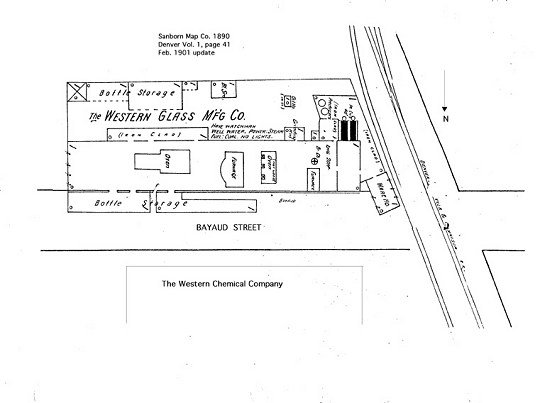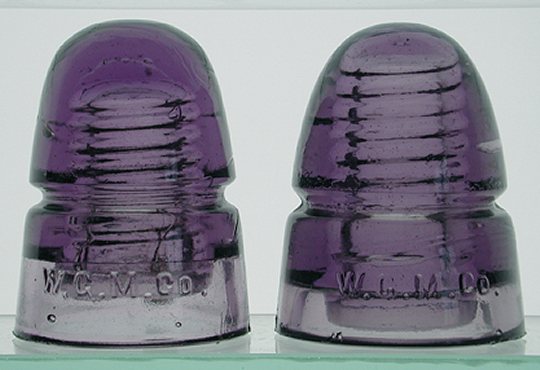PART I: THE BEGINNINGS
Over the years, several articles on the Denver glass companies operating out
of the Valverde Glass Works have been published in the Crown Jewels of the Wire.
Most recently, we've heard about the R. Good Jr. operation and the Western Flint
Glass Company. These accounts concentrated on the "insulators" part of
the story. Now it's time to transition to the even more interesting historical
aspects of early glass making in Denver and speak to the "people and the
times" of the Western Glass Manufacturing Company.

The Origin of WGM Co.
"I was limited for capital. That tank wasn't what it should have been,
but I was getting by with it, until the fire¹." These were the words of
Robert Good Jr. when discussing the disastrous fire of June 27th, 1899 which
ended his western entrepreneurial adventure and "threw about 30 people out of employment."²
Possibly watching the fire from his office across Bayaud Street was Mr. Frank
Ashley, the genial secretary and treasurer of the Western Chemical Co. of which
his father, Eli, was principal owner, president and general manager.³ It was
Frank Ashley who became the driving force behind the creation of the Western
Flint Glass Company (WFG Co) upon the embers of Robert Good JR's business.
Joining Frank were a few of his boyhood buds, sons of Denver's upper crust who
all lived on or within a block of Denver's millionaires row, Grant St. on
Capitol Hill.(4) Frank became president of the new firm. Merritt W. Gano, of the
noted downtown gentlemen's clothing firm Gano-Downs, took over as business
manager.

TYPICAL USE OF THE FIVE WGM INSULATOR STYLES
|
STYLE
|
UTILIZATION
|
REPRESENTATIVE USERS
|
|
CD 106
|
Rural telephone
|
Colorado Tel Co. (CO and NM), Rocky Mt Bell Tel Co.
(UT, ID, MT, WY)
|
|
CD 121
|
Telephone toll Lines
|
Colorado Tel Co. (CO and NM), Rocky Mt Bell Tel
Co. (UT, ID, MT, WY)
|
|
CD 134
|
Low voltage power
|
Denver Gas and Electric, & most other local
power companies
|
|
CD 145
|
Railroad Telegraph
|
WU, AT&SF, Postal Tel, Union Pacific RR
|
|
CD 162
|
Low voltage power
|
Denver Gas and Electric, & most other local
power companies
|
Other shareholders were Gerald Hughes, whose father was a leading attorney in
Denver and would soon become a U.S. Senator, and John H. Porter. Porter's
father, Henry M. Porter, as a young man, had been employed by the Stebbins
Telegraph Company and had constructed the telegraph line from Kansas City to
Omaha via St. Joseph in 1860. The following year, Porter was superintendent of
the Stebbins contract to construct the Omaha-Julesburg portion of the Pacific
Telegraph for Western Union Telegraph Co. (5)
The initial capitalization of WFG was $25,000.(6) On February 7th, 1900, an
amendment to the Certificate of Incorporation was filed with the Colorado
Secretary of State increasing the capital stock to $40,000.
Despite this auspicious beginning, all was not well. "... the plant was
poorly equipped and had been operated more or less unsuccessfully."(7)
Perhaps also the blue and green glass, while attractive in an insulator, may not
have been acceptable in a beer or catsup bottle. This was to change in the
summer of 1900. Henry Porter writes to son John on July 10, 1900: "Frank
Ashley was around the other evening and said that they had secured the services
of an excellent man to run the glass works. He was out and looked over the
situation for five days and has concluded to come to Denver to live, and thinks
that he can make the works pay from one to two hundred dollars a day. Fifty dollars a day would be an improvement
on what is being done now. He has gone back to St. Louis to arrange his affairs
and will be out soon with his family and will take charge of the works as a
permanent thing.

WGM Hutch bottles from around the region
(Perhaps as much as 85% of the WGM
revenue
came from the manufacture of bottles)

Crown top beer and soda bottles from various parts
of the "WGM sales
region"
"Frank says they pay him $175 a month and put five thousand in the
treasury and give him the profits arising from that for the first year; next
year they give him the profit and one thousand (shares) of the stock, the third
year the same, and the fourth year the same, and the fifth year all of the stock
if he carries out his promises.
"They all seem to think a great deal of this man and the record that he
had made in St. Louis, the long years he had managed there, and the success that
he and his brother made in the business."(8)
Dateline ALTON, IL July 21, 1900: "Michael Nester is here from Denver,
Col., endeavoring to enlist some Alton glassblowers to go West with him to work
(the) next fire at the Western Flint Glass Co. plant at Valverde, near Denver,
which he will manage next year."(9)
And again September 4,1900, Henry Porter to son John: "The glass works
have taken an evolution to the front since you were here. They have a new man by
the name of Nester who was a great success east, who has engaged himself for five years, who has made some changes, who is to take
part of his pay in stock of the company provided he makes what he agrees to. The
company will increase its capitol stock to 80,000, Frank Ashley and you to pay
2000 each more and get 6000 more stock or 14,000 each...I paid 1000 for you and
will pay 1000 more.

Top Row: Tolls in four colors from one of the four molds
Bottom Row: Four
mold toll set

Top Row: Ponies in all four molds
Bottom Row: Additional pony color variants

Several mold variants of the Western Union style
WGM 145's

Group photo of Denver glass showing various colors and styles
"Nester thinks he can make 100 to 200 per day if he can sell the glass
and they are making arrangements to sell to the beer men a big lot of stuff, say
50,000 worth I believe.
"They all like the new man, he is quiet and methodical, and understands
what he is doing and going to do.(10)
John Porter, in Magdelena, New Mexico, replies to his father on September
6th, 1900: "I note what you say about the Glass Co. and am glad to know
that they have things, as I think, in better shape...I am obliged for the
additional stock you took for me and hope that it will turn out good. It should
in time."(11)
Michael Nester learned the glass trade from his father, Fred Nester, in one
of the Pittsburgh glass houses. The family moved to Illinois Glass in Alton in
1882. In 1893, they purchased a portion of the Obear Glass Co. of East St.
Louis, IL. The name was changed Obear-Nester Glass Co. with Michael's elder
brother Joseph Nester becoming president.(12)
In Denver, one of the first changes Michael Nester made was the introduction
of manganese into the glass chemistry to de colorize the glass. New insulator
molds, embossed "WGM Co" were purchased and the old WFG molds that had
been Robert Good JR's were retired...at least for awhile. The new corporation,
Western Glass Manufacturing Co., now capitalized at $100,000, filed its
certificates with the Secretary of State on November 8th, 1900.(13) This change
of name may have been part of the attempt to polish their image, but more likely
it was to resolve a conflict - there was an existing Western Flint Glass Co. in
Eaton, Indiana.(14)
- to be continued -
(A tip of the old hat to historian Bob Stahr who has been mining the musty
old files of the Commoner & Glassworker - and other journals. Some of the
fruits of Bob's labor are incorporated into this article.)

Notes:
1. Quoted in the Poughkeepsie Sunday New Yorker, Mar 11, 1945
2. Denver Post, June 27, 1899
3. Denver Post, September 24, 1899
4. Sandra Dallas: Cherry Creek Gothic, Norman, OK, 1971
5. H.M. Porter:
Pencilings of an Early Western Pioneer 1929
6. September 14, 1899, State
of Colorado Archives
7. Commoner & Glassworker, April 18, 1903
8. Porter Papers: Colorado Historical Society Library
9. Commoner & Glassworker, April 18, 1903. (Glass works in this period
operated from after Labor Day to the end of June; this season was known as
"a fire")
10. Porter Papers op cit
11. Ibid.
12. East St. Louis Journal, February 21, 1893 and Commoner & Glassworker
Apr 18, 1903
13. Colorado State Archives
14. Dick Roller: Indiana Glass Factories Notes, Paris, IL 1994

Group photo of WGM glass
(Note many of these are embossed AMTEL and WFG!)

WGM styles: Postal (left) VS. Western Union (right)
a) The Postal style molds
have a base dimension of 2-15/16"
whereas the WU style bases are all 3-1/8".
b) There are four separate molds for each style
distinguished by the
shape of the dome.

WGM PONY with large bubble in skirt

WGM TOLL with black "pollywog"


































































